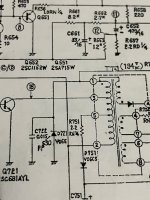PS: .....''the voltage on the cathode (positive side of D721) is not supposed to be 194V DC, it is a narrow peak pulse (the flyback pulse) with a base close to zero volts and only about 10uS wide and it peaks to around 200v. This pulse passes via the fusible resistor R753, and is peak rectified by diode D753 (though on my schematic it looks like D253 in the label) and stored as a DC level on the capacitor C753, which is where you should find about 190V DC.
It is misleading that they have named that point on the schematic on D721 as 194V DC. If you check there with a scope (scope on 50V/cm with a x10 probe), you would find that the voltage that you see on the cathode of D721, is almost identical to that on the collector of the HOT (Test point 18), just a little higher in level. There are only a few turns on the flyback transformer between its pins 1 & 3.
Shorting out the CRT to discharge it can potentially cause trouble, it won't damage the flyback transformer, but it can damage transistors on the pcb, depending on the ground point that it is discharged into, because the peak currents can be surprisingly high, and the stored energy for a CRT of this size can be in the order of 50mJ to 150mJ, this is not enough to harm a person as a single discharge, aside from getting a fright, but enough to damage transistors & IC's if present. If you did get a zap from it, it would feel like a single pulse from a car spark plug or lawn mower plug.
(The CRT bulb capacitance is in the range of 500pF to 1000pF and if charged to 12kV the stored energy is (12000)^2 x 1000 E-12 /2 = 0.072 J = 72mJ )
For most repairs, you don't need to go under the anode cap, and the CRT charge stays safely in the CRT bulb. If you want to go under the anode cap within minutes of turning the set off, it is better to discharge the CRT with an EHT probe, which has a very high value resistor in it, typically 100 M Ohm or greater and limits the peak current to a very low value much less than a milliamp. The EHT rectifier in the flyback assembly has a non zero reverse leakage, so the other way is just to leave the set un-powered overnight and the CRT bulb charge largely self dissipates and you can go under the anode cap when the charge has largely depleted to a low value on its own.

